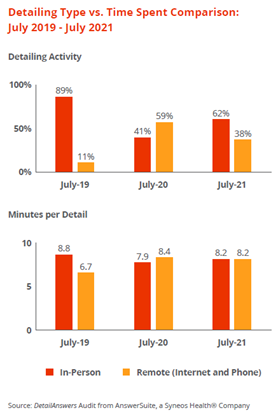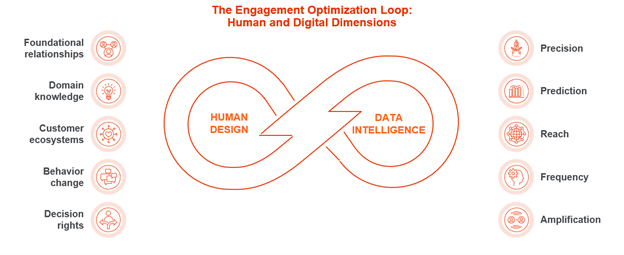The Engagement Optimization Loop: 2022 Health Trends
2022 Health Trends
How do we work differently to fuel efficiency and effectiveness in 2022 and beyond?
That may be the biggest question among commercial leadership teams right now as they validate learnings from the last two years and debate new models for the new normal.
That validation is critical. The organizations that are leveraging the provisional insights hard-earned in times of rapid change, through multiple fielded experiments, have the distinct advantage of evolving from experience.
Talk of future commercialization models once imagined a shift to hyper-efficient digital channels with automated relationship engines. What the industry has learned is that a simple transfer of resources from high cost / low frequency interactions and low cost / high frequency channels is not enough.
Instead, the new optimization loop requires both a highly effective field and highly efficient digital. In the new models we know the customer as well as the technology; know the data as well as the business. Increasingly the industry is putting relationships first, then fueling those relationships with digital amplification and improving them with transparency to data and signals of intent. The end game is nothing less than data-driven value creation. Even as human interactions remain front and center, our machine-learning systems will start acing tasks that eluded them until now. That is, helping managers navigate oceans of data—sometimes messy, or siloed, or locked in brittle dashboards—so we can aggregate what matters and draw insights from data to inform decision making.
Four things are clear across the industry as we enter 2022:
- Relationships remain at the core of healthcare; they are the great accelerator of growth
- Multiple channels act as extenders of those relationships consistently driving more success
- Insights should flow across channel boundaries
- Agility requires those insights to be incredibly close to sources of execution
Looking across industry, as new commercial models emerge in 2022 they will have two key dimensions: the human and the digital.
The human dimension includes the foundational relationships between the field and healthcare decision makers and influencers. It thrives on domain knowledge, works in local customer ecosystems and demands advanced strategy in areas as diverse as behavior change, organizational design, decision rights and incentive strategy.
The digital dimension is built on precision, prediction, reach and frequency. It uses omnichannel engagement—the seamless interweaving of integration, personalization and automation—to amplify critical human interactions and deliver powerful insights on when and how to act most efficiently in all channels. Healthcare professionals expect Amazon-like experiences at work. Omnichannel is the evolving way we do that in our industry.
Learn more about our modern customer engagement capability, Kinetic™
There are several shifts happening in each dimension that will shape the landscape ahead:

The Human Dimension
1. More time than ever
More specialties are opening their doors to reps, moving the preponderance of meetings to face-to-face. But the early data show an interesting trend: video and phone visits are not decreasing at the same rate that face-to-face is increasing, suggesting that some doctors are spending more total time with the field than they did pre-pandemic. The expectation for engagement across channels may require an increase in commercial capacity in the years ahead.
Interested in more data intelligence around HCP preferences? Learn about AnswerSuite.

2. Local ecosystem management
Commercial teams are unleashing the power of experienced field leaders, asking them to bring the whole of their judgement and experience to bear in local markets. This year, many will be empowered to customize field strategy for unique patient populations, healthcare professional audiences and organized customer infrastructure. In close collaboration with partners in medical, marketing and managed markets, these entrepreneurial leaders will blend data and local customer insights to optimize resourcing and tailor engagement to achieve the right mix of personal and omnichannel engagement, field roles and custom solutions to address market needs.
3. Increasingly medicalized field
A new talent pool born out of a healthcare industry in the midst of radical change and deployed with incredible peer knowledge and empathy has the potential to radically reshape the field. In one survey of 400 physicians more than half said they were planning an employment change amidst the pandemic, with one-third considering early retirement or a career change. That potential recruitment pool of physicians and other medical employees steps forward with domain experience and front-line understanding of today’s healthcare business challenges.
Learn more about our medical field team solutions.
4. Medical affairs transformation
Connecting clinical development and commercialization with strategic insight is an ever-evolving medical affairs engine. Medical affairs, including real world evidence (RWE), is increasingly moving upstream in the product development process, driving new ways to understand the patient journey and the larger medical context those patients are living in.
The Digital Dimension
1. The living call plan
Advanced analytics have enabled us to identify our highest-potential prescribers and ecosystem partners. In 2022, field leaders are increasingly asking: who else? Teams are using highly efficient digital media to reach healthcare professionals in tiers just below the ones the field is actively calling on to look for signals of interest. When a prescriber or stakeholder interacts with an ad or visits a particular website, that digital hand raise is elevated to the field team for prioritized interaction.
2. Digital reinforcement
Once a valuable field-to-prescriber contact is made, field enablement tools increasingly recommend a next best action. Those actions often involve additional field burden, like sending an email with targeted content, setting a follow-up program or triggering a peer action. In 2022, those next best actions will increasingly be automated, leveraging media and other channels to automatically amplify the work of the field based on business rules connected to information already collected in customer relationship management (CRM) systems.
Learn how a true Virtual Sales Organization can optimize commercial business impact by flexibly blending personal interactions with state-of-art virtual engagement.
3. Cascading precision analytics
The key expectation in the optimized engagement loop model is performance. To ensure it, teams need measurement that has a bias for action, fueling new behaviors that have of-the-moment relevance for both sales professionals and customers. Look for growth in cascading, personalized dashboards that show each field leader, rep or customer-facing team member, and omnichannel partner exactly where they’re seeing success and where they need to take specific steps to meet performance goals. Our industry has too long relied exclusively on high-latency data (e.g. prescribing, EHRs). These new approaches will leap forward to give teams insight into what’s happening right now.
4. Data-driven value creation
Every week, life sciences companies amass incomprehensibly huge troves of data from health-relevant events and transactions. But how often do we see and act on the value in the data? Rarely indeed, industry leaders say. Above all, what we seek internally and from partners is the ability to use data-driven insights to inform decision making. Today’s data systems may allow us to choose among several dozen dashboards reflecting an equal number of data sources. But they provide few clues on how this all condenses into just five decisions we urgently need to discuss with clients, or the board, or investors, or direct reports. In 2022, machine learning systems will begin to address this critical function—not as the result of a two-year-long AI development program, but as the routine output of an agile “sprint” lasting no longer than four to 12 weeks.

Certainly, there is a great enthusiasm for these new models, but there are threats to their success as well. One of the greatest is Post-Pilot Deceleration. Many organizations have watched this change lag happen. A passionate marketing team pilots a new model, often in very entrepreneurial ways, with success. Yet, teams around them continue operating in the ways they’re used to.
The drive to consistency in how teams go to market is critical to achieving the engagement optimization loop's full potential in 2022 and far beyond it. Look for leaders to focus on increasing insight-based decision making, cultural agility, breaking down functional silos and bringing strategy closer to the point of execution.
Get the printable PDF of Engagement Optimization Loop here.
Or, subscribe below to our monthly email to receive exclusive updates.

